Stories
Stories
Mossie Memories
The de Havilland Mosquito, famously known as the “Wooden Wonder,” left a lasting mark on the memories of the pilots who flew it during World War II. With its exceptional speed, agility, and versatility, the Mosquito became legendary, and those who piloted it recalled the bond they shared with this remarkable aircraft.
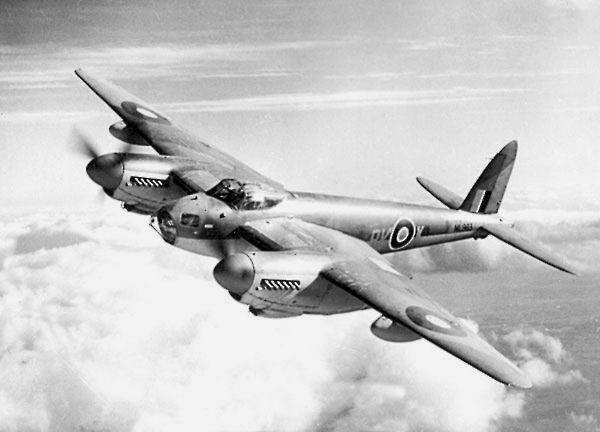
Caption: A Royal Air Force de Havilland Mosquito B.XVI, ML963, 8K-K “King” of No. 571 Squadron in September 1944. ML963 completed 84 operations with the Squadron, 31 of them to Berlin. Its final sortie came on 10/11 April 1945, when it was abandoned following an engine fire. (Credit: United Kingdom Government).
Mossie for Me – Bill Simpson
“The Mossie was always my favourite type; even later in the 1950s and 60’s, when flying jets, the memory of how good the Mossie was has never left me”.
“On 109 (PFF) Squadron I had some great moments in them. On March 2, 1945, in MM295-P, the famous Grim Reaper with at least 120 Ops, I marked for 858 Bomber Command aircraft over Cologne. Ten days later I was marking again for 1008 heavy bombers over Dortmund (in MM114-G)”.
“Both were incredibly heavy raids and an amazing sight as something like 8,000,000 lbs of high explosive was dropped on a single target. It was unbelievable that anything could survive such as destruction, but it did.”
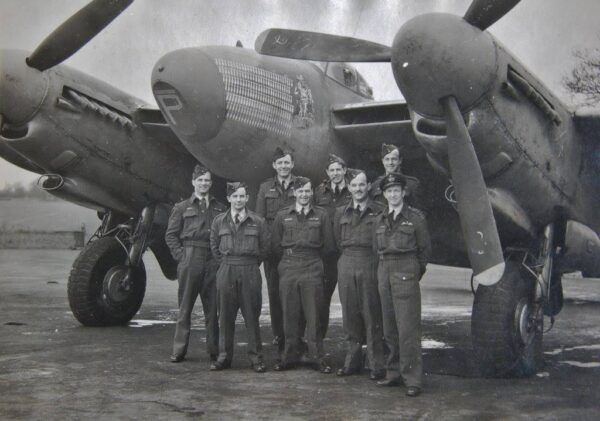
Kiwi pilots on No. 109 Squadron. At back left to right are Alfred Relph, Beryck Dalcom, Alexander Wigley, Frank Beswick and in front John McGreal, Noel Roseman, William (Bill) Simpson, and Albert Stevenson. They are standing with the famous Mosquito, The Grim Reaper, by then coded Bar P. This aircraft did a remarkable number of ops, sometimes two in one night, but with different crews.
(Credit: NZBCA Archive)
Serving on 109 Sq. in 1944/45 were ten New Zealanders: Frank Beswick, Keith Boles DFC, Beryck Dalcom, Alan Dray DFC, John McGreal DFC, Alfred Relph DFC, Noel Roseman, Bill Simpson DFC, Albert Stevenson, and Alexander Wigley.
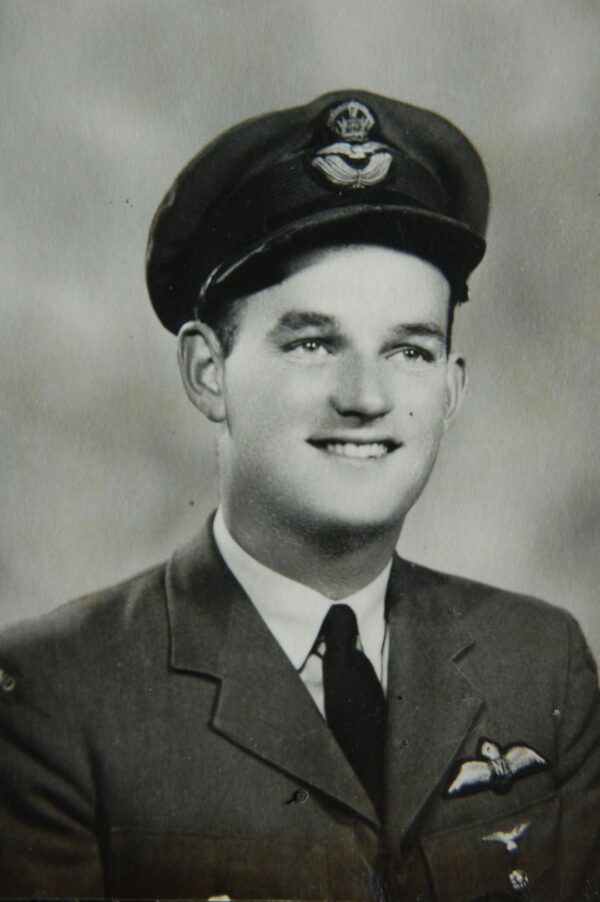
Bill Simpson
Post-war, Simpson was flying in the Central Signals Establishment. “I was flying out of Watton on radar development was taking a Mossie up to 58,000 feet over Buchan. It took a while to get there, and she wasn’t happy just mushing along, but what an aircraft. It gave the GCI radar boys who were tracking us something to think on, as 60,000 feet was at the limit of most of the RAF jet fighters of the time”.
Bill Simpson was instrumental in founding the New Zealand Command Association and was major force in ensuring the restoration and safe housing of the Lancaster at Auckland’s Museum of Transport and Technology.
Nothing like a Mossie – Ted Kepplewhite
“I first flew a mossy at 51 TU, and later with 25 squadron at Castle Camps and finally on 488 (NZ) Squadron until wars end when were based at Gilze in Holland.”.
“I’d always enjoyed aerobatic since my Harvard days at Wigram. A transfer to an OTU put me into the driver seat of the beautiful mosquito. Even the well-used models we had were a delight to fly – quick, great visibility and very aerobatic!”
“After the course I was posted to 25 Sq. at Castle Camps in 1944, where we flew intruder missions over Germany giving some protection to the bomber stream. I’d hang back out of the stream sitting at maybe 30,000 feet and tried to pick up the exhaust glow of the German night fighters”.
“When the buzz bomb raids on London started after June 1944, we were put on tonight defence of the capital”.
“By the end of my tour the logbook score stood at 7 damaged as I was never keen to follow the ‘flamers’ down to see them crash. I knew they were gone, and I was better off staying up in the action looking for another.”
“For a break from operations I pulled drones around for hapless gunners and pilots. I wasn’t in a Mossie then of course but found it more dangerous than being behind the bomber stream over Germany.
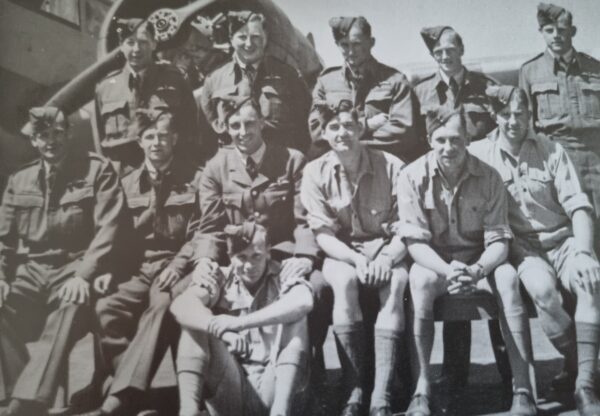
Caption: Flying Instructors, student pilots and crew, Wigram 1942.
(Credit: NZBCA Archives)
“I joined 488 (NZ) Sq. in 1945, this time on Mk XXXs. Again they were great to fly. I spent a lot of time in the maintenance hangar. The engineering and mechanical side of things had a great fascination especially the beautifully made Merlin engines. It certainly helped when I raced motorbikes after the war.”
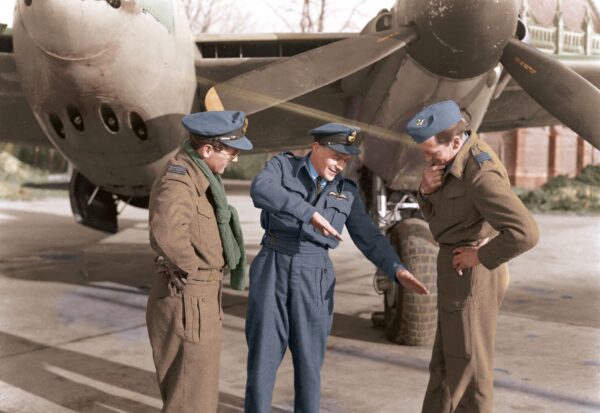
Caption: No. 488 New Zealand Squadron officers discussing a dog-fight in front of a Mosquito. Believed to be at Gilze-Rijen, Holland. 1945.
(Credit: Air Force Museum of New Zealand)
Note that No. 488 (NZ) Squadron RAF, was not a Bomber Command squadron. Having been disbanded as an RNZAF fighter squadron after evacuation from Singapore in February 1942, 488 Sq. was reformed as a night-fighter and intruder unit, responsible for intercepting enemy aircraft at night. Most of the pilots were New Zealanders, with many of the navigators being drawn from British RAF personnel.
Based at RAF Church Fenton, they were initially equipped with the Bristol Beaufighter before re-equipping with the De Havilland Mosquito in 1943. After D-Day (6 June 1944), the Squadron operated from bases in France and the Netherlands.
Several members of the Squadron were highly successful in combat. The top scoring New Zealand night fighter pilot was Flight Lieutenant George Jameson who, along with his English navigator Norman Crookes, destroyed 11 enemy aircraft, including four on a single night in 1944. In total, the Squadron accounted for 67 confirmed enemy aircraft and several others probable or damaged.